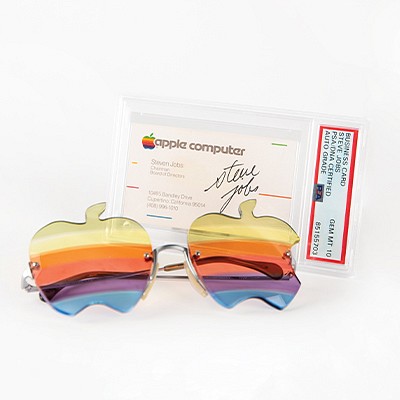Douglas Engelbart Coding Keyset Presented to a Fellow Researcher from SRI International
Two ways to bid:
- Leave a max absentee bid and the platform will bid on your behalf up to your maximum bid during the live auction.
- Bid live during the auction and your bids will be submitted real-time to the auctioneer.
Bid Increments
| Price | Bid Increment |
|---|---|
| $0 | $5 |
| $50 | $10 |
| $200 | $25 |
| $500 | $50 |
About Auction
Mar 21, 2024
RR Auction's March 2024 sale chronicles Steve Jobs and the Apple revolution, with additional featured items from the realms of vintage computing and video games. Highlighted by Steve Jobs autographs and memorabilia—including ultra-rare Apple Computer checks, significant signed letters, and business cards—the auction also plays host to a wide variety of original Apple hardware, including a functional Apple-1 Computer, colorful iMacs, scores of new-in-box iPods, and sealed iPhones. RR Auction support@rrauction.com
- Lot Description
Scarce chorded keyset input device created by computer pioneer Douglas Engelbart, similar to the type used in his iconic 1968 'Mother of All Demos,' which was personally gifted by computer visionary Douglas Engelbart to his friend and colleague, Bill Daul, who was a member of Engelbart's pioneering research team at SRI. The keyset, made in an uncommon black-and-brown theme, measures 5″ x 5.5″ x 1.25″ and features five keys (permitting 31 key-press combinations), for typing and entering commands. The underside of the keyset features an affixed label, “Cybernex, Palo Alto, California,” marked in red felt tip, “Keyset #68.” The device retains its braided rainbow cord, terminating in a serial connector. In fine condition.
The five-button coding keyset was first publicly demonstrated in the 'Mother of All Demos,' where Engelbart presented many of the technological ideas that are now commonplace—including the computer mouse, hypertext, multiple windows, video conferencing, and shared editing of online documents. The keyset was meant to supplement—not replace—a traditional keyboard. Where a keyboard required a user to lift their hand from the mouse and look away from the screen, the keyset allowed them to continue using the mouse while typing by pressing down multiple switches simultaneously to make 'chords,' like a piano player. Using binary code, each 'chord' would input a specific character.
The keyset and Engelbart's three-button mouse also worked together—the keyset's 31 combinations permitted input of all 26 letters of the alphabet, plus standard punctuation marks (comma, period, semicolon, question mark, and space). Used in conjunction with the keyset, the mouse buttons functioned as shift and command keys: with the middle button pressed, letters shifted to uppercase and other punctuation marks were accessible; pressing the left mouse button allowed entry of numbers and a further selection of punctuation and symbols.
The 'Mother of All Demos' would prove to be massively influential, though it took well over a decade for Engelbart's ideas to become mainstream. In the early 1970s, much of Engelbart's original team ended up at Xerox PARC, where they continued their research in human-computer interaction and kept improving upon the mouse. While touring Xerox PARC in 1979, Steve Jobs witnessed the concepts of the mouse and the graphical user interface (GUI) in action. Impressed by their user-friendliness, he aimed to simplify and incorporate these intuitive features into Apple's computers. - Shipping Info
-
Bidder is liable for shipping and handling and providing accurate information as to shipping or delivery locations and arranging for such. RR Auction is unable to combine purchases from other auctions or affiliates into one package for shipping purposes. Lots won will be shipped in a commercially reasonable time after payment in good funds for the merchandise and the shipping fees are received or credit extended, except when third-party shipment occurs. Bidder agrees that service and handling charges related to shipping items which are not pre-paid may be charged to a credit card on file with RR Auction. Successful international Bidders shall provide written shipping instructions, including specified Customs declarations, to RR Auction for any lots to be delivered outside of the United States. NOTE: Declaration value shall be the item’(s) hammer price and RR Auction shall use the correct harmonized code for the lot. Domestic Bidders on lots designated for third-party shipment must designate the common carrier, accept risk of loss, and prepay shipping costs.
-
- Buyer's Premium



 EUR
EUR CAD
CAD AUD
AUD GBP
GBP MXN
MXN HKD
HKD CNY
CNY MYR
MYR SEK
SEK SGD
SGD CHF
CHF THB
THB







